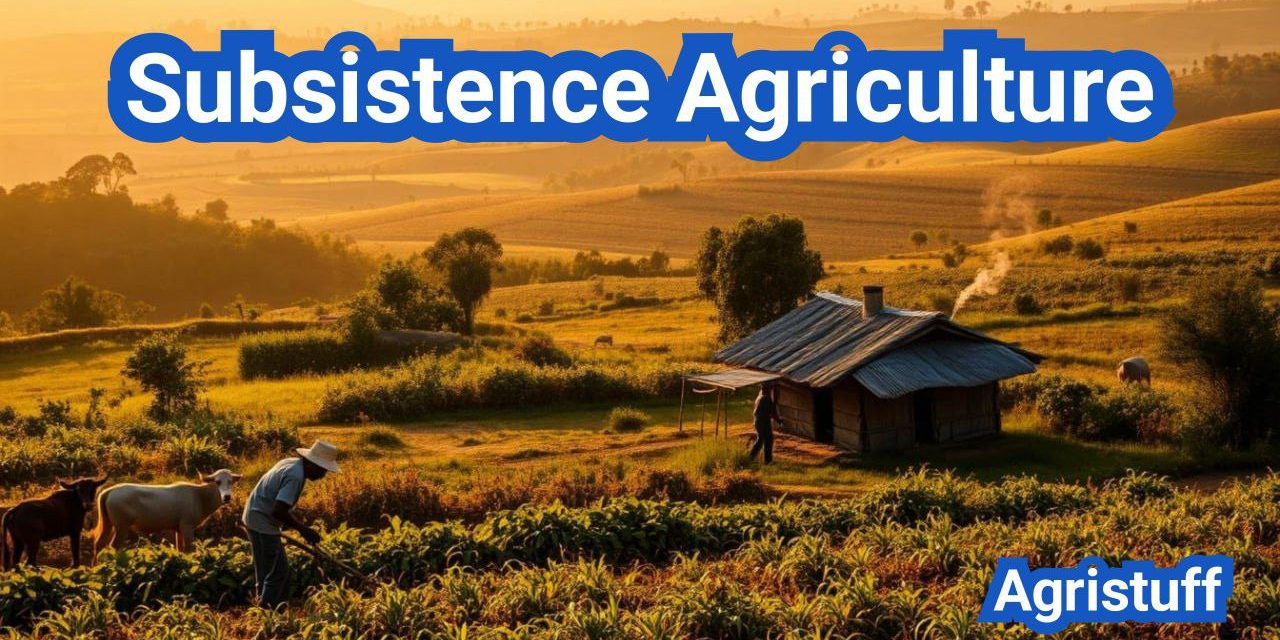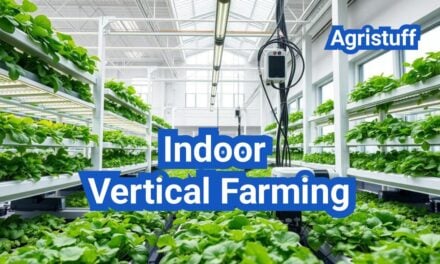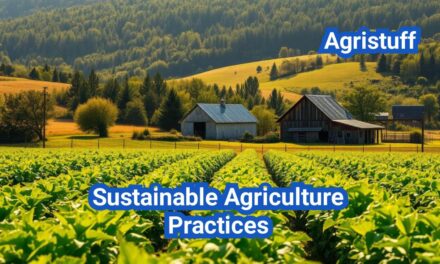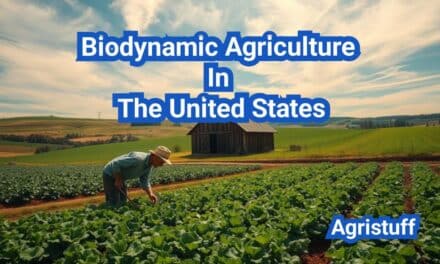Subsistence agriculture is a vital practice where farmers cultivate crops on smallholdings to meet their family’s needs.
This traditional farming method is crucial for achieving food security and promoting sustainable rural development. By growing their own food, families can rely on a steady supply of nutritious produce.
The significance of self-sufficient farming lies in its ability to support local communities and preserve traditional farming practices.
Key Takeaways
- Subsistence agriculture is a vital practice for food security.
- It promotes sustainable rural development.
- Self-sufficient farming supports local communities.
- Traditional farming practices are preserved.
- Subsistence farming provides a steady supply of nutritious produce.
Understanding Subsistence Agriculture
At its core, subsistence agriculture is about cultivating the land to meet the basic needs of a family or community. This traditional farming practice has been the backbone of rural livelihoods for centuries, providing sustenance and a means of survival.
Definition and Core Concepts
Subsistence agriculture definition encompasses farming practices that focus on growing enough food to sustain the farmer and their family. It is characterized by the use of traditional farming techniques, limited use of external inputs, and a reliance on family labor. The subsistence farming definition highlights its primary goal: to produce food for consumption rather than for sale.
Historical Development and Significance
Subsistence agriculture has a rich history, dating back to ancient times when it served as the primary means of food production. Until around 1800, it was the dominant mode of production in Europe and North America. The historical significance of subsistence agriculture lies in its ability to provide food security and support local economies.
The development of subsistence agriculture is closely tied to the evolution of human societies. As populations grew, the need for reliable food sources became increasingly important. Subsistence farming allowed communities to settle and cultivate the land, leading to the development of more complex societies.
Key Characteristics of Subsistence Farming
Subsistence farming is characterized by several key features, including:
- Reliance on family labor
- Use of traditional farming techniques
- Limited use of external inputs such as fertilizers and machinery
- Focus on growing a diverse range of crops to meet household needs
Intensive subsistence agriculture involves farming a small plot of land intensively to maximize yields. This approach is often used in areas with high population densities. In contrast, sedentary agriculture involves farming the same plot of land over a long period, allowing for the development of more permanent farming systems.
| Characteristics | Intensive Subsistence Agriculture | Sedentary Agriculture |
|---|---|---|
| Land Use | Small plots, intensively farmed | Same plot farmed over long periods |
| Labor | High labor input | Labor input varies by crop |
| Crops | Diverse crops for household needs | May include cash crops alongside staple foods |
Major Types of Subsistence Agriculture

Subsistence farming is not a one-size-fits-all approach; it includes several distinct types tailored to different environments and needs. These diverse farming practices are crucial for the survival and livelihood of millions of people worldwide.
Shifting Cultivation (Slash and Burn)
Shifting cultivation, also known as slash and burn agriculture, is a traditional farming method used in many tropical regions. It involves clearing a patch of forest land by felling and burning trees, then growing crops on the cleared land.
Characteristics of Shifting Cultivation:
- Temporary use of land for farming
- Relies on natural soil fertility
- Often practiced in areas with low population density
As noted by a forestry expert, “Shifting cultivation is a complex system that has been practiced for centuries, with both positive and negative impacts on the environment.”
“The slash and burn method can be sustainable if done with long fallow periods, but it’s often criticized for deforestation and soil degradation when practiced intensively.”
Intensive Subsistence Farming
Intensive subsistence farming involves cultivating the same plot of land continuously, using techniques like irrigation and terracing to maximize yield.
Key Features:
| Feature | Description |
|---|---|
| Land Use | Continuous cultivation of the same land |
| Techniques | Irrigation, terracing, and crop rotation |
| Yield | High yield per hectare |
Nomadic Herding
Nomadic herding involves the movement of people and their livestock between different grazing areas in search of food and water.
Advantages:
- Adaptability to harsh environments
- Diversified livestock for various products
Sedentary Agriculture
Sedentary agriculture refers to farming practices where the farmer remains in one place, cultivating the same land year after year.
Benefits:
- Improved soil fertility through crop rotation
- Increased food security through consistent production
In conclusion, the various types of subsistence agriculture each have their unique characteristics, advantages, and challenges. Understanding these differences is crucial for supporting and improving subsistence farming practices globally.
Regional Subsistence Farming Practices
The diversity of subsistence farming practices around the world is a testament to the adaptability and resilience of rural communities. These practices are deeply rooted in local cultures, traditions, and environmental conditions.
Asian Subsistence Farming Models
In Asia, subsistence farming is often characterized by intensive cultivation of crops such as rice, wheat, and maize. These farming systems are typically labor-intensive and rely on traditional techniques passed down through generations.
Key Features of Asian Subsistence Farming:
- High population density
- Small landholdings
- Use of traditional farming techniques
- Focus on staple crops
African Subsistence Practices
African subsistence farming is diverse, with practices varying significantly across different regions. Shifting cultivation and nomadic herding are common in many areas.
| Region | Common Crops | Farming Practices |
|---|---|---|
| West Africa | Cassava, yams | Shifting cultivation |
| East Africa | Maize, beans | Intercropping |
| Southern Africa | Millet, sorghum | Dryland farming |
Latin American and Indigenous Approaches
In Latin America, indigenous communities practice subsistence farming that is closely tied to their cultural heritage. Techniques such as agroforestry are commonly used.
Agroforestry, for example, involves integrating trees into farming systems, which helps maintain biodiversity and improve soil health.
Urban Subsistence Agriculture
Urban subsistence agriculture is becoming increasingly important as cities grow. This involves growing food in urban areas, often using innovative techniques such as vertical farming and container gardening.
Urban subsistence farming not only provides fresh produce to city dwellers but also helps to mitigate the urban heat island effect and improve air quality.
How to Establish a Subsistence Farm

Subsistence farming is a rewarding venture that begins with understanding the suitability of your land and climate. This foundational knowledge is crucial for creating a productive and sustainable farm that meets your family’s needs.
Assessing Land and Climate Suitability
The first step in establishing a subsistence farm is to assess the land and climate conditions. This involves evaluating factors such as soil quality, slope, and drainage, as well as understanding the local climate patterns, including temperature ranges and precipitation levels.
| Land Characteristics | Ideal Conditions | Actions for Improvement |
|---|---|---|
| Soil Quality | Well-draining, fertile soil | Add organic matter, crop rotation |
| Slope | Gentle slope for water retention | Terracing for steep slopes |
| Drainage | Adequate drainage to prevent waterlogging | Install drainage systems if necessary |
Climate suitability is equally important, as it affects the types of crops you can grow and the livestock you can raise. Understanding the local microclimate can help you make informed decisions about your farming practices.
Creating a Year-Round Production Calendar
A year-round production calendar is essential for ensuring a continuous supply of food from your subsistence farm. This involves planning which crops to plant at different times of the year and how to care for them.
- Identify the crops suitable for your climate and soil type.
- Plan the planting schedule based on the crop requirements and growth cycles.
- Include a mix of annuals and perennials for a diverse harvest.
Setting Realistic Self-Sufficiency Goals
Setting realistic self-sufficiency goals is vital for the success of your subsistence farm. This involves determining what you want to achieve in terms of food production and how you plan to get there.
Consider factors such as the size of your family, dietary preferences, and the resources available to you. By setting achievable goals, you can create a roadmap for your farming activities and track your progress over time.
Essential Crops and Livestock Selection
The foundation of a thriving subsistence farm lies in choosing the appropriate staple food crops and livestock. This selection process is critical as it directly impacts the farm’s productivity, nutritional output, and overall sustainability.
Staple Food Crops Selection Guide
Staple food crops are the backbone of subsistence farming, providing the primary source of nutrition and energy. Crops such as maize, cassava, and sweet potatoes are popular choices due to their hardiness and nutritional value. When selecting staple crops, it’s essential to consider factors like climate, soil type, and resistance to pests and diseases.
For instance, maize is a versatile crop that thrives in various conditions, making it an ideal choice for many subsistence farmers. According to agricultural experts, “Maize is not only a staple food but also a valuable source of income for many smallholder farmers” (Source: FAO Report on Maize Production). Cassava, on the other hand, is known for its drought tolerance and ability to grow in poor soil, making it a reliable crop for areas with challenging environmental conditions.
| Crop | Nutritional Value | Climate Tolerance |
|---|---|---|
| Maize | Rich in carbohydrates, fiber, and vitamins | Thrives in temperate and tropical climates |
| Cassava | High in carbohydrates, vitamin C, and minerals | Tolerant of drought and poor soil |
| Sweet Potatoes | Rich in vitamins A and C, fiber, and minerals | Prefers well-drained soil and temperate climates |
Integrating Small Livestock for Protein Sources
In addition to staple crops, integrating small livestock is crucial for providing a balanced diet rich in protein. Animals like chickens, goats, and rabbits are excellent choices for subsistence farms due to their relatively low maintenance and high nutritional output.
For example, chickens are not only a source of protein through eggs and meat but also assist in pest control by consuming insects that could harm crops. As noted by agricultural specialists, “Integrating poultry into farming systems can enhance biodiversity and improve farm resilience” (Source: Sustainable Agriculture Review).
- Chickens: Provide eggs and meat, assist in pest control
- Goats: Offer meat and milk, can thrive on marginal lands
- Rabbits: Fast breeders, provide meat, and require minimal space
Balancing Nutritional Needs in Crop Selection
Achieving a balanced diet is a key objective of subsistence farming. This involves selecting a mix of crops that together provide a broad spectrum of nutrients. Intercropping and crop rotation are effective strategies for maintaining soil health and ensuring a diverse nutritional output.
For example, planting legumes alongside cereals can enhance soil fertility through nitrogen fixation, while also providing a more balanced nutritional profile. As agricultural experts suggest, “Diversifying crop portfolios can significantly improve dietary diversity and farm resilience” (Source: Agriculture for Nutrition and Health).
By carefully selecting staple food crops and integrating small livestock, subsistence farmers can create a robust and sustainable farming system that meets their nutritional needs and enhances their overall well-being.
Subsistence Farming Methods and Techniques

Understanding various subsistence farming methods is essential for farmers worldwide. These techniques are vital for promoting sustainable agriculture and ensuring food security. Subsistence farming relies on a combination of traditional knowledge and innovative practices to maximize yields while minimizing environmental impact.
Implementing Effective Crop Rotation
Crop rotation is a fundamental technique in subsistence farming. It involves rotating different crops on the same land to maintain soil fertility and reduce pests and diseases. Effective crop rotation can improve soil structure, increase nutrient availability, and enhance biodiversity.
A well-planned crop rotation cycle can be divided into several stages:
- Legumes to fix nitrogen
- Cereals to utilize nitrogen
- Root crops to break disease cycles
| Crop Type | Benefits | Examples |
|---|---|---|
| Legumes | Nitrogen fixation, soil improvement | Beans, peas, lentils |
| Cereals | High yield, staple food | Rice, maize, wheat |
| Root Crops | Disease resistance, food security | Potatoes, cassava, yams |
Mastering Intercropping Strategies
Intercropping is another effective technique used in subsistence farming. It involves growing two or more crops together on the same field. This method can enhance biodiversity, improve resource utilization, and increase overall yields.
Successful intercropping requires careful planning and selection of compatible crops. For example, planting marigolds with tomatoes can help deter nematodes.
Natural Pest Management Techniques
Natural pest management is crucial for maintaining the health of subsistence farms. Techniques such as using biological controls, cultural controls, and resistant crop varieties can effectively manage pests without harming the environment.
Some effective natural pest management strategies include:
- Using beneficial insects like ladybugs and lacewings
- Practicing crop rotation to break pest cycles
- Employing physical barriers to protect crops
By implementing these subsistence farming methods and techniques, farmers can improve their agricultural productivity and contribute to sustainable food systems.
Tools and Technologies for Subsistence Agriculture

Effective subsistence agriculture is rooted in the use of suitable tools and technologies that improve farm productivity. The right equipment can significantly reduce labor, enhance crop yields, and promote sustainability.
Essential Hand Tools and Their Uses
Hand tools are the backbone of subsistence farming, providing farmers with the means to cultivate, maintain, and harvest their crops efficiently. Essential hand tools include:
- Hoes for weeding and soil preparation
- Machetes for clearing vegetation and harvesting
- Rakes for soil leveling and crop management
These tools are vital for farmers to manage their land effectively, and their proper use can lead to improved crop yields.
Animal-Powered Equipment Options
Animal-powered equipment represents a significant advancement in subsistence farming, offering a more efficient alternative to manual labor. Plows and carts are examples of equipment that can be powered by animals like oxen or horses, enabling farmers to cultivate larger areas and transport goods more effectively.
Appropriate Modern Adaptations
While traditional tools remain crucial, modern adaptations can further enhance subsistence farming. Technologies such as drip irrigation systems and solar-powered pumps can improve water management, reducing the manual labor involved in irrigation. Additionally, simple mechanized tools, like seed drills, can increase planting efficiency.
By integrating these tools and technologies, subsistence farmers can improve their productivity, reduce their workload, and contribute to a more sustainable agricultural practice.
Sustainable Practices in Subsistence Farming

Implementing sustainable practices in subsistence farming is essential for ensuring food security and environmental conservation. Subsistence farmers, who produce food primarily for their families and local communities, play a crucial role in maintaining the health of the land and conserving natural resources.
Soil Conservation and Improvement Techniques
Soil conservation is critical in subsistence farming to prevent erosion and maintain fertility. Techniques such as contour plowing and terracing help reduce soil erosion on sloping lands. Additionally, practices like mulching and cover cropping enhance soil health by adding organic matter and reducing the need for synthetic fertilizers.
| Technique | Description | Benefits |
|---|---|---|
| Contour Plowing | Plowing across slopes to reduce erosion | Reduces soil loss, conserves water |
| Terracing | Creating flat plots on slopes | Prevents erosion, allows for more cultivation area |
| Mulching | Covering soil with organic material | Retains moisture, suppresses weeds, improves soil health |
Water Management and Conservation Strategies
Effective water management is vital for subsistence farming, especially in areas with limited rainfall. Techniques such as rainwater harvesting and drip irrigation help conserve water and ensure its efficient use. Farmers can also adopt drought-tolerant crop varieties to minimize the impact of water scarcity.
- Rainwater harvesting: Collecting and storing rainwater for irrigation
- Drip irrigation: Delivering water directly to the roots of plants
- Drought-tolerant crops: Planting crops that require less water
Biodiversity Preservation Methods
Preserving biodiversity is essential for maintaining ecosystem services that support subsistence farming. Practices such as agroforestry and crop rotation help maintain a diverse range of plant and animal species. This not only enhances ecosystem resilience but also provides farmers with a variety of food sources and income opportunities.
By adopting these sustainable practices, subsistence farmers can improve their livelihoods while contributing to environmental conservation. It’s a win-win approach that ensures the long-term sustainability of their farming activities.
Overcoming Common Challenges in Subsistence Agriculture

Farmers engaged in subsistence agriculture encounter a range of challenges that impact their ability to produce food sustainably. These challenges can be broadly categorized into environmental, economic, and social factors. Understanding and addressing these challenges is crucial for improving the livelihoods of subsistence farmers and ensuring food security.
Managing Climate Vulnerability
Subsistence farmers are particularly vulnerable to climate change due to their reliance on rain-fed agriculture and limited resources to adapt to changing weather patterns. Climate vulnerability can lead to crop failures, reduced yields, and decreased food security. To manage this challenge, farmers can adopt climate-resilient agricultural practices such as using drought-tolerant crop varieties, implementing conservation agriculture, and improving soil health.
Additionally, farmers can benefit from climate information services that provide weather forecasts and advisories, enabling them to make informed decisions about planting, harvesting, and other farming activities.
Maximizing Limited Resources and Land
Subsistence farmers often have limited access to resources such as land, water, and capital, making it challenging to maintain productivity. To maximize limited resources, farmers can implement efficient farming practices such as intercropping, crop rotation, and integrated pest management. These practices not only improve yields but also reduce the need for external inputs.
Furthermore, farmers can explore alternative uses for their land, such as agroforestry or livestock production, to diversify their income streams and improve overall farm resilience.
Navigating Market Integration When Necessary
While subsistence farmers primarily produce for their own consumption, they may occasionally need to engage with markets to sell surplus produce or purchase inputs. Market integration can be challenging due to factors such as limited market access, price volatility, and lack of market information.
To navigate these challenges, farmers can form or join farmer organizations that can help them access markets, negotiate better prices, and share market information. Additionally, farmers can explore alternative market channels such as direct-to-consumer sales or online platforms to improve their market access.
Food Security Through Subsistence Agriculture

Ensuring food security through subsistence agriculture is a multifaceted approach that involves various farming practices. Subsistence agriculture is crucial for achieving food security, particularly in rural areas where access to commercial food markets may be limited.
Planning for Continuous Harvest Cycles
One of the key strategies in achieving food security through subsistence agriculture is planning for continuous harvest cycles. This involves:
- Selecting a diverse range of crops with different maturation periods
- Implementing succession planting to ensure a steady supply of produce
- Using techniques like intercropping to maximize land use efficiency
By adopting these strategies, subsistence farmers can enjoy a continuous supply of fresh produce throughout the year, enhancing their food security.
Food Storage and Preservation Methods
Effective food storage and preservation are critical components of food security in subsistence agriculture. Some common methods include:
- Drying: Removing moisture from crops to prevent spoilage
- Smoking: Preserving food by exposing it to smoke
- Canning: Storing food in airtight containers to maintain freshness
- Root cellars: Storing produce in cool, dark environments to prolong shelf life
These methods help subsistence farmers preserve their harvest, ensuring a steady food supply even during periods of scarcity.
Nutritional Balance in Subsistence Production
Achieving nutritional balance is essential in subsistence agriculture to ensure that the food produced meets the dietary needs of the family. This involves:
- Growing a mix of staple crops, vegetables, and fruits
- Raising livestock for protein sources
- Incorporating legumes to enhance soil fertility and provide protein
By diversifying their production, subsistence farmers can ensure a balanced diet, improving overall health and well-being.
Benefits of Subsistence Farming

The benefits of subsistence farming are multifaceted, ranging from economic self-sufficiency to the preservation of cultural heritage. Subsistence farming plays a crucial role in promoting sustainable rural development by providing a means of living for millions of people worldwide.
Economic Advantages and Self-Reliance
Subsistence farming offers significant economic advantages, primarily through self-reliance. By producing their own food, farmers reduce their dependence on external markets, thereby shielding themselves from price fluctuations and market uncertainties. As noted by agricultural experts, “subsistence farming allows families to save money that would otherwise be spent on food purchases, which can then be allocated to other essential needs.”
Economic self-reliance is further enhanced through the diversification of crops and livestock, which not only provides a varied diet but also serves as a buffer against crop failures or livestock diseases. This diversification is a key strategy in managing risk and ensuring a stable food supply.
Environmental Benefits
Subsistence farming is often associated with sustainable agricultural practices that have numerous environmental benefits. These practices include crop rotation, intercropping, and the use of organic amendments, all of which contribute to soil health and biodiversity. By maintaining soil fertility and structure, subsistence farmers can ensure long-term productivity without degrading the environment.
“Subsistence farming promotes ecological balance by preserving traditional crop varieties and farming methods that are adapted to local conditions.”
Cultural and Social Significance
Beyond its economic and environmental benefits, subsistence farming holds significant cultural and social value. It is often deeply intertwined with the cultural heritage of communities, preserving traditional knowledge and practices passed down through generations. Subsistence farming also fosters community cohesion through shared farming practices and mutual support networks.
The cultural significance of subsistence farming is reflected in its ability to maintain agricultural biodiversity and preserve traditional farming techniques. This not only contributes to the richness of local cultures but also provides a sense of identity and continuity for farming communities.
Transitioning Between Subsistence and Commercial Agriculture

Transitioning from subsistence to commercial farming requires careful planning and consideration of various factors. Subsistence farmers may need to scale their production to increase their income and improve their livelihoods. This transition involves a significant shift in farming practices, market engagement, and resource management.
Identifying When to Scale Production
Deciding when to scale production is crucial for a successful transition. Farmers should assess their current production levels, market demand, and available resources. Key indicators for scaling production include:
- Increased market demand for their products
- Availability of additional land or resources
- Access to new markets or distribution channels
- Improved farming techniques or technology
Farmers must also consider the potential risks and challenges associated with scaling up, such as increased labor costs, higher input requirements, and market fluctuations.
Maintaining Sustainability During Transition
Maintaining sustainability during the transition to commercial agriculture is vital to ensure long-term viability. This involves adopting practices that minimize environmental impact, conserve resources, and promote social equity. Sustainable practices may include:
| Practice | Description | Benefits |
|---|---|---|
| Crop Rotation | Alternating crops to maintain soil fertility | Improved soil health, reduced pests and diseases |
| Organic Amendments | Using natural materials to enhance soil fertility | Reduced chemical use, improved soil structure |
| Integrated Pest Management | Combining techniques to manage pests and diseases | Reduced chemical use, improved crop yields |
By incorporating these practices, farmers can reduce their environmental footprint and improve the sustainability of their operations.
Preserving Subsistence Principles in Commercial Settings
While transitioning to commercial agriculture, it’s essential to preserve the core principles of subsistence farming, such as self-sufficiency, resourcefulness, and community engagement. Strategies for preserving these principles include:
- Maintaining a diverse range of crops and livestock
- Engaging with the local community through farmers’ markets or cooperatives
- Implementing conservation practices to protect natural resources
By balancing commercial goals with subsistence principles, farmers can create a more resilient and sustainable agricultural operation.
The Future of Subsistence Agriculture in a Changing World
Subsistence agriculture remains a vital component of global food systems, promoting food security and sustainable rural development. As the world grapples with climate change, the future of subsistence agriculture hangs in the balance.
Sustainable practices in subsistence farming can help mitigate the effects of climate change while ensuring local communities’ food security. By adopting climate-resilient techniques and preserving biodiversity, subsistence farmers can continue to thrive in a changing world.
The key to the future of subsistence agriculture lies in its ability to adapt to changing environmental conditions while maintaining its core principles of sustainability. As we move forward, it is essential to support subsistence farmers in their efforts to promote ecological balance and community well-being.
FAQ
What is subsistence agriculture?
Subsistence agriculture is a type of farming where farmers grow crops and raise livestock primarily for their own family’s consumption, rather than for sale or commercial purposes.
What are the key characteristics of subsistence agriculture?
Key characteristics of subsistence agriculture include small-scale production, family-based labor, limited use of technology and external inputs, and a focus on self-sufficiency.
What are the different types of subsistence agriculture?
The main types of subsistence agriculture are shifting cultivation, intensive subsistence farming, nomadic herding, and sedentary agriculture.
How do subsistence farmers manage climate vulnerability?
Subsistence farmers manage climate vulnerability by using techniques such as crop rotation, intercropping, and conservation agriculture, as well as by diversifying their crops and livestock.
What are the benefits of subsistence agriculture in achieving household food security?
Subsistence agriculture provides a reliable source of food for households, improves nutrition, and enhances food security, particularly in rural areas.
How can subsistence farmers achieve agricultural self-sufficiency?
Subsistence farmers can achieve agricultural self-sufficiency by diversifying their crops and livestock, improving their farming techniques, and conserving natural resources.
What role does subsistence agriculture play in building food sovereignty?
Subsistence agriculture plays a crucial role in building food sovereignty by enabling communities to control their own food systems, preserve their cultural heritage, and promote sustainable agriculture practices.
How can subsistence farmers transition to commercial agriculture?
Subsistence farmers can transition to commercial agriculture by scaling up their production, improving their marketing skills, and accessing new markets and technologies.
What are some traditional farming methods used in subsistence agriculture?
Traditional farming methods used in subsistence agriculture include crop rotation, intercropping, and conservation agriculture, as well as the use of local crop and animal varieties.
What tools and technologies are used in subsistence agriculture?
Tools and technologies used in subsistence agriculture include hand tools, animal-powered equipment, and simple irrigation systems, as well as modern adaptations such as drip irrigation and conservation agriculture equipment.
How does subsistence agriculture contribute to sustainable practices?
Subsistence agriculture contributes to sustainable practices by promoting soil conservation, biodiversity preservation, and efficient water use, as well as by reducing the use of external inputs and improving the overall sustainability of farming systems.
Conclusion of: Subsistence Agriculture
Subsistence agriculture is one of the oldest forms of farming, practiced for thousands of years by people seeking to grow enough food to meet the needs of themselves and their families. While industrial and commercial agriculture dominate global food markets today, subsistence agriculture remains the backbone of rural life in many parts of the world.
In this article, we’ll break down what subsistence agriculture is, its major types, the technology and tools it employs, its benefits, and some real-world examples — all while ensuring the content is optimized for search engine performance.
What Is Subsistence Agriculture?
Subsistence agriculture is a self-sufficient farming system in which farmers grow food primarily for their own consumption rather than for trade or sale in the market. It typically involves small plots of land, basic tools, family labor, and low input costs.
Unlike commercial agriculture, which focuses on maximizing output for profit, subsistence agriculture prioritizes survival. It is common in regions with limited access to markets or capital, especially in parts of Africa, Asia, and Latin America.
Learn more from the FAO about subsistence farming
Types of Subsistence Agriculture
There are several forms of subsistence agriculture, each suited to the environment and cultural traditions of the region in which it is practiced.
1. Shifting Cultivation
Also known as slash-and-burn agriculture, this method involves clearing a forested area, farming it for a few years, and then moving to a new plot once the soil becomes less fertile.
More on shifting cultivation from Britannica
2. Nomadic Herding
Common in arid and semi-arid regions, this type of subsistence agriculture involves moving livestock from place to place in search of water and pasture.
Explore nomadic herding in more detail
3. Intensive Subsistence Farming
Practiced in densely populated areas like South and Southeast Asia, this method focuses on maximizing yields from small plots using manual labor and traditional techniques.
FAO’s insights on intensive farming
4. Primitive Subsistence Farming
This is the most basic form of subsistence agriculture, using no mechanization and relying heavily on natural rainfall and hand tools.
More about primitive agriculture from ThoughtCo
Tools Used in Subsistence Agriculture
In subsistence agriculture, tools are typically simple and manually operated. These include:
- Hoes – used for tilling and weeding.
- Sickles – for harvesting grains and grasses.
- Plows – either hand-pulled or animal-drawn.
- Baskets and containers – for transporting produce.
These tools are inexpensive, easy to use, and often passed down from generation to generation.
An overview of traditional farming tools from World Bank
Technologies in Subsistence Agriculture
Although traditional by nature, subsistence agriculture is gradually being influenced by low-cost, accessible technologies:
1. Mobile Agriculture (mAgri)
Mobile phones are helping farmers receive weather updates, crop advice, and market prices, even in remote regions.
GSMA’s Mobile for Agriculture program
2. Solar Irrigation
Small solar-powered pumps offer affordable irrigation options to subsistence farmers without access to electricity.
More on solar irrigation by Powering Agriculture
3. Improved Seed Varieties
Non-GMO hybrid seeds with better drought tolerance and pest resistance are improving yields.
Research by CGIAR on seed technology
Benefits of Subsistence Agriculture
Despite its low productivity compared to modern farming, subsistence agriculture offers many benefits:
1. Food Security for Families
The primary goal of subsistence agriculture is to feed the household, which provides a safety net in rural economies.
UN World Food Programme on local food production
2. Environmental Sustainability
Because of its small scale and reliance on natural resources, subsistence agriculture often has a lower environmental footprint.
WWF on sustainable agriculture
3. Cultural Preservation
Farming traditions, crop varieties, and local knowledge are preserved through generational farming practices.
Cultural heritage and farming: FAO
4. Low External Inputs
The low dependency on chemical fertilizers, pesticides, and commercial seeds makes it cost-effective.
IFOAM on organic and low-input farming
Challenges Facing Subsistence Agriculture
While subsistence agriculture offers resilience and food sovereignty, it also faces challenges:
- Low productivity
- Limited access to markets
- Vulnerability to climate change
- Lack of infrastructure and education
USAID agricultural development challenges
Examples of Subsistence Agriculture Around the World
1. Sub-Saharan Africa
In countries like Ethiopia and Uganda, most rural families engage in subsistence agriculture, growing maize, beans, and sorghum.
2. South Asia
Rice paddies in Bangladesh and Nepal represent classic intensive subsistence agriculture systems.
India’s Ministry of Agriculture data
3. Amazon Rainforest
Indigenous tribes practice shifting cultivation and fish farming to meet household needs.
UN Indigenous Peoples and traditional farming
4. Andean Highlands
Farmers cultivate potatoes and raise llamas under traditional methods adapted to high altitudes.
Global Agriculture article on Andes farming
How Can Subsistence Agriculture Be Improved?
Sustainable improvement of subsistence agriculture is possible through:
- Agroecology principles
- Access to microfinance
- Community-based extension services
- Investment in rural infrastructure
- Education and gender empowerment
Final Thought
Subsistence agriculture may not receive as much global attention as commercial farming, but it remains the lifeline for millions of households worldwide. As we move toward more sustainable and inclusive food systems, supporting and improving subsistence farming through appropriate technologies, education, and infrastructure is essential. Recognizing its value not just in feeding families but in preserving culture, ecosystems, and rural livelihoods is key to a resilient agricultural future.










